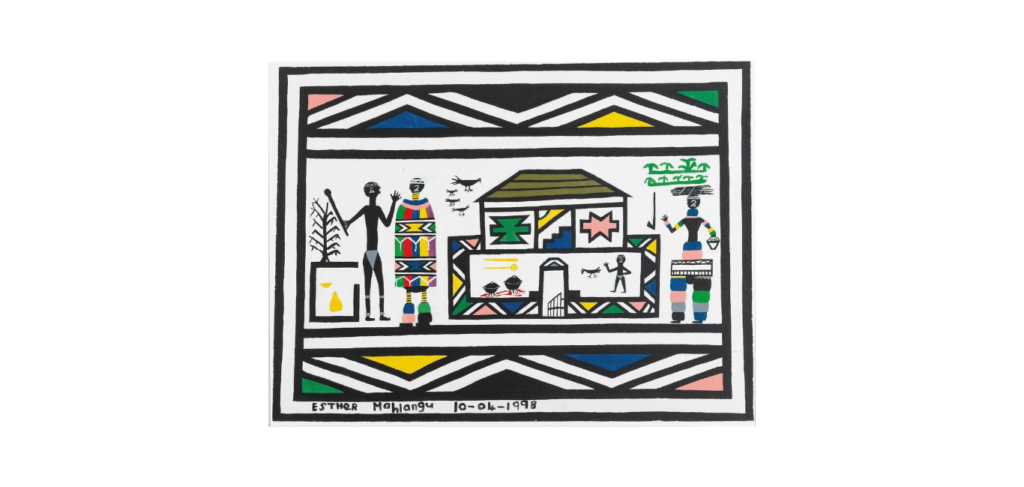In the realm of great artists, names like da Vinci, Van Gogh, and Picasso stand tall. Yet, amidst them shines Esther Mahlangu—a powerhouse of vibrant creativity. She was born on November 11, 1935, in the heart of South Africa’s Ndebele nation. Mahlangu embodies contemporary African art in its purest, most expressive form. Her bold, large-scale paintings beautifully capture the visual richness of her Ndebele heritage.
Mahlangu’s art goes beyond existence; it speaks, sings, and tells captivating stories. Each piece engages in a vivid conversation with the observer, unveiling the tales of the Ndebele people. Inspired by Ndebele’s clothing and jewelry, her work is a vibrant tapestry of patterns. Mahlangu’s generous use of geometric shapes and vibrant colors express a culture that thrives and evolves.

Her rise to international acclaim is as intriguing as it is inspiring. In 1989, Mahlangu’s unique style and expression captured the hearts of Europeans at the “Magiciens de la Terre” art exposition. Her international breakthrough came when BMW invited her to contribute to their esteemed Art Car project in 1991. With her signature flair, Mahlangu transformed a BMW 525i into the first “African Art Car.”
This remarkable automobile, adorned with motifs from the Ndebele ethnic group, shattered boundaries in the art world and made history. Mahlangu became the first non-Western and female artist to design a BMW Art Car. Her vibrant creation was exhibited at prestigious institutions, including the National Museum of Women in the Arts in Washington, DC, in 1994, and the British Museum in London in 2017.
Mahlangu’s art is not just personal expression; it preserves the collective memory of her people. Her technique follows a tradition passed down exclusively by women, intricately connected to the ancient practice of decorating houses during the boys’ rite of passage. This blend of personal creativity and cultural heritage gives her work a profound depth and resonance.

Her impact on art is undeniable, with exhibitions at renowned institutions worldwide. From the Centre Pompidou in Paris to the Virginia Museum of Fine Arts in Richmond, USA, and the Guggenheim Museum in Bilbao, Spain, her art continues to captivate audiences. Mahlangu’s work took center stage at the “South Africa: The Art Of a Nation” exhibition at the British Museum.
Notably, her art has also achieved record-breaking prices at auctions, emphasizing her global appeal. In 2020, “African Symphony,” an ensemble of Ndebele symbols, sold at Sotheby‘s for an astounding $141,000—a testament to the soaring demand for contemporary African art.
Mahlangu’s deep connection to her Ndebele heritage, nurtured by her mother and grandmother, shapes her unique style. Beyond her artwork, she established the Esther Mahlangu Art School in her native village, preserving and passing on traditional Ndebele painting techniques to younger generations.
Esther Mahlangu is more than an artist; she is a storyteller, cultural ambassador, and symbol of Ndebele’s resilience. Through her vibrant paintings, she invites the world to savor the rich tapestry of Ndebele culture. Her journey and achievements inspire a new generation of artists to express their cultural identities with pride and creativity. Mahlangu’s legacy reminds us that art transcends boundaries and connects hearts.


